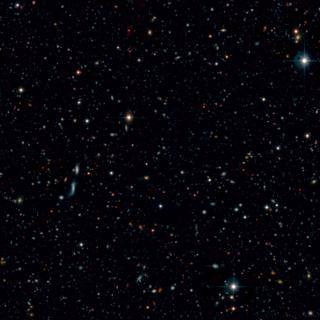Bibcode
Castro-Tirado, A. J.; Gupta, R.; Pandey, S. B.; Nicuesa Guelbenzu, A.; Eikenberry, S.; Ackley, K.; Gerarts, A.; Valeev, A. F.; Jeong, S.; Park, I. H.; Oates, S. R.; Zhang, B. -B.; Sánchez-Ramírez, R.; Martín-Carrillo, A.; Tello, J. C.; Jelínek, M.; Hu, Y. -D.; Cunniffe, R.; Sokolov, V. V.; Guziy, S.; Ferrero, P.; Caballero-García, M. D.; Ror, A. K.; Aryan, A.; Castro Tirado, M. A.; Fernández-García, E.; Gritsevich, M.; Olivares, I.; Pérez-García, I.; Castro Cerón, J. M.; Cepa, J.
Referencia bibliográfica
Astronomy and Astrophysics
Fecha de publicación:
3
2024
Revista
Número de citas
9
Número de citas referidas
6
Descripción
Context. Dark gamma-ray bursts (GRBs) constitute a significant fraction of the GRB population. In this paper, we present a multi-wavelength analysis (both prompt emission and afterglow) of an intense (3.98 × 10−5 erg cm−2 using Fermi-Gamma-Ray Burst Monitor) two-episodic GRB 150309A observed early on until ∼114 days post burst. Despite the strong gamma-ray emission, no optical afterglow was detected for this burst. However, we discovered near-infrared (NIR) afterglow (KS-band), ∼5.2 h post burst, with the CIRCE instrument mounted at the 10.4 m Gran Telescopio Canarias (hereafter, GTC).
Aims: We aim to examine the characteristics of GRB 150309A as a dark burst and to constrain other properties using multi-wavelength observations.
Methods: We used Fermi observations of GRB 150309A to understand the prompt emission mechanisms and jet composition. We performed early optical observations using the BOOTES robotic telescope and late-time afterglow observations using the GTC. A potential faint host galaxy was also detected in the optical wavelength using the GTC. We modelled the potential host galaxy of GRB 150309A in order to explore the environment of the burst.
Results: The time-resolved spectral analysis of Fermi data indicates a hybrid jet composition consisting of a matter-dominated fireball and magnetic-dominated Poynting flux. The GTC observations of the afterglow revealed that the counterpart of GRB 150309A was very red, with H − KS > 2.1 mag (95% confidence). The red counterpart was not discovered in any bluer filters of Swift UVOT/BOOTES, which would be indicative of a high redshift origin. Therefore we discarded this possibility based on multiple arguments, such as spectral analysis of the X-ray afterglow constrain z < 4.15 and a moderate redshift value obtained using the spectral energy distribution (SED) modelling of the potential galaxy. The broadband (X-ray to NIR bands) afterglow SED implies a very dusty host galaxy with a deeply embedded GRB (suggesting AV ≳ 35 mag).
Conclusions: The environment of GRB 150309A demands a high extinction towards the line of sight. Demanding dust obscuration is the most probable origin of optical darkness as well as the very red afterglow of GRB 150309A. This result establishes GRB 150309A as the most extinguished GRB known to date.
Aims: We aim to examine the characteristics of GRB 150309A as a dark burst and to constrain other properties using multi-wavelength observations.
Methods: We used Fermi observations of GRB 150309A to understand the prompt emission mechanisms and jet composition. We performed early optical observations using the BOOTES robotic telescope and late-time afterglow observations using the GTC. A potential faint host galaxy was also detected in the optical wavelength using the GTC. We modelled the potential host galaxy of GRB 150309A in order to explore the environment of the burst.
Results: The time-resolved spectral analysis of Fermi data indicates a hybrid jet composition consisting of a matter-dominated fireball and magnetic-dominated Poynting flux. The GTC observations of the afterglow revealed that the counterpart of GRB 150309A was very red, with H − KS > 2.1 mag (95% confidence). The red counterpart was not discovered in any bluer filters of Swift UVOT/BOOTES, which would be indicative of a high redshift origin. Therefore we discarded this possibility based on multiple arguments, such as spectral analysis of the X-ray afterglow constrain z < 4.15 and a moderate redshift value obtained using the spectral energy distribution (SED) modelling of the potential galaxy. The broadband (X-ray to NIR bands) afterglow SED implies a very dusty host galaxy with a deeply embedded GRB (suggesting AV ≳ 35 mag).
Conclusions: The environment of GRB 150309A demands a high extinction towards the line of sight. Demanding dust obscuration is the most probable origin of optical darkness as well as the very red afterglow of GRB 150309A. This result establishes GRB 150309A as the most extinguished GRB known to date.
Final (optical/ir) images+spectra are available at the CDS via anonymous ftp to cdsarc.cds.unistra.fr (ftp://130.79.128.5) or via https://cdsarc.cds.unistra.fr/viz-bin/cat/J/A+A/683/A55
Proyectos relacionados

Evolución de Galaxias
El estudio de la evolución de las galaxias es un tema crucial de la Astronomía Extragaláctica moderna. Permite vincular las galaxias locales con las primeras que existieron en el universo. Pero para poder abordarlo es preciso obtener censos estadísticamente significativos de galaxias de distintas luminosidades, a distintas distancias
Jorge
Cepa Nogue